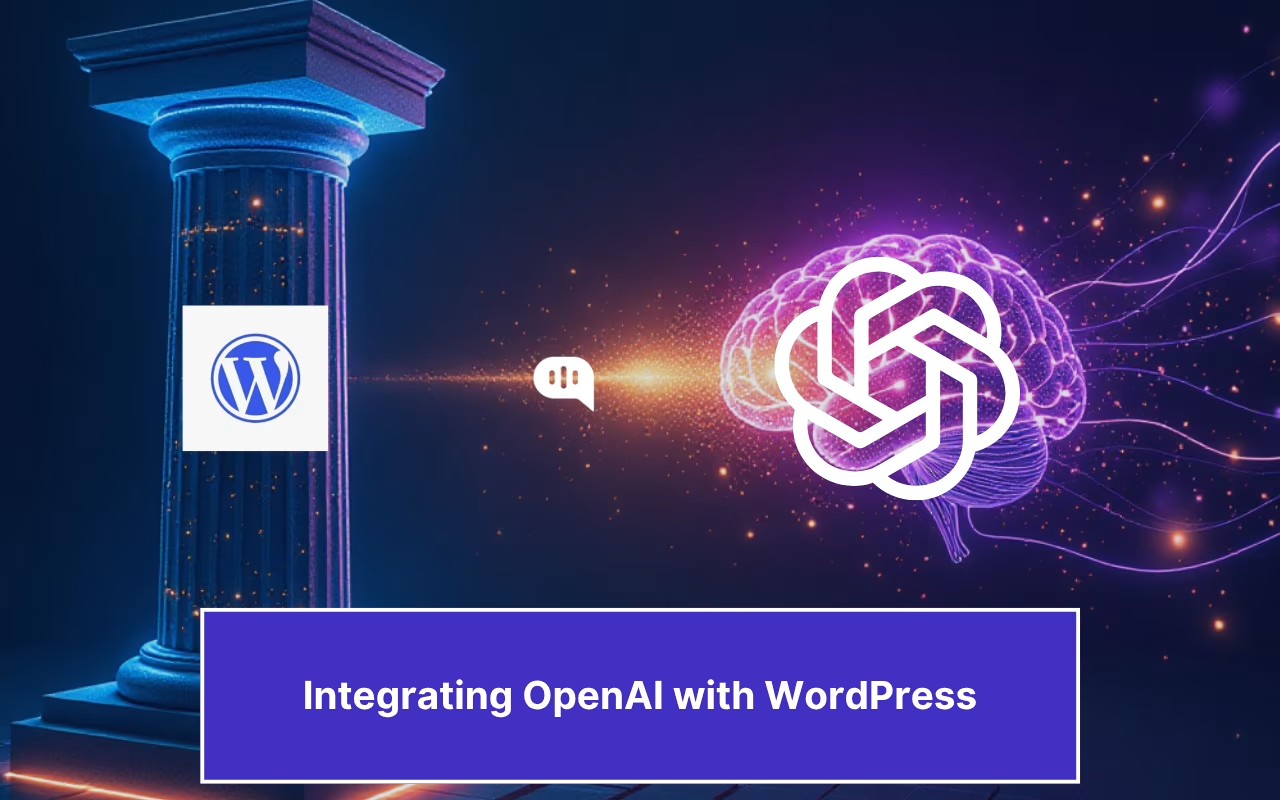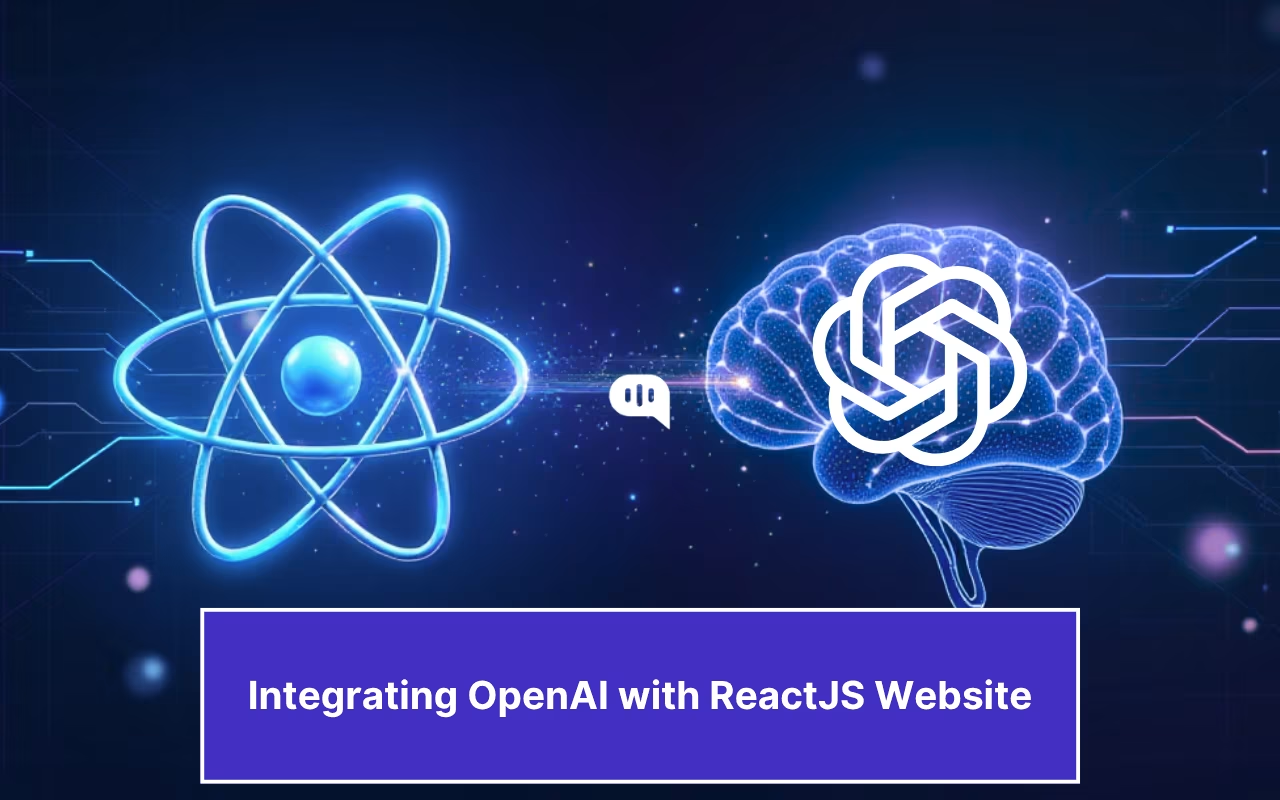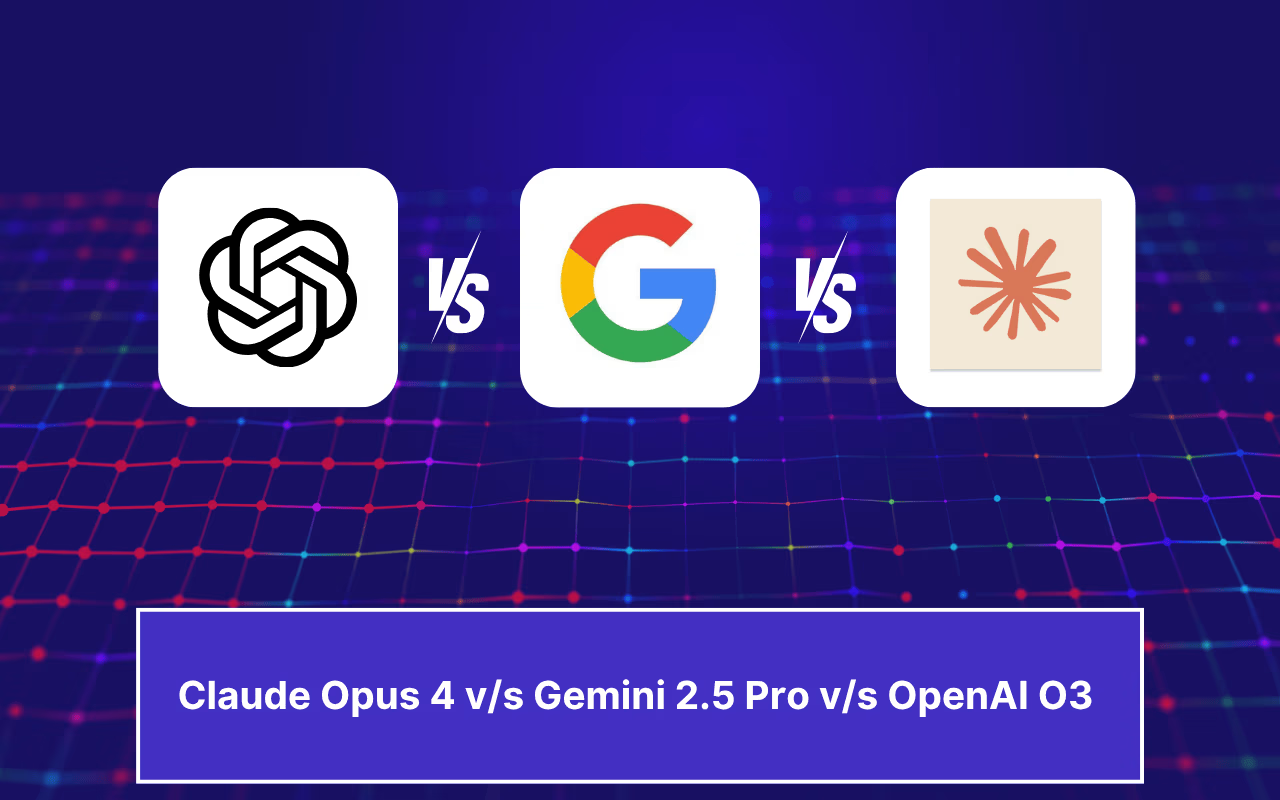Updated on July 6, 2025
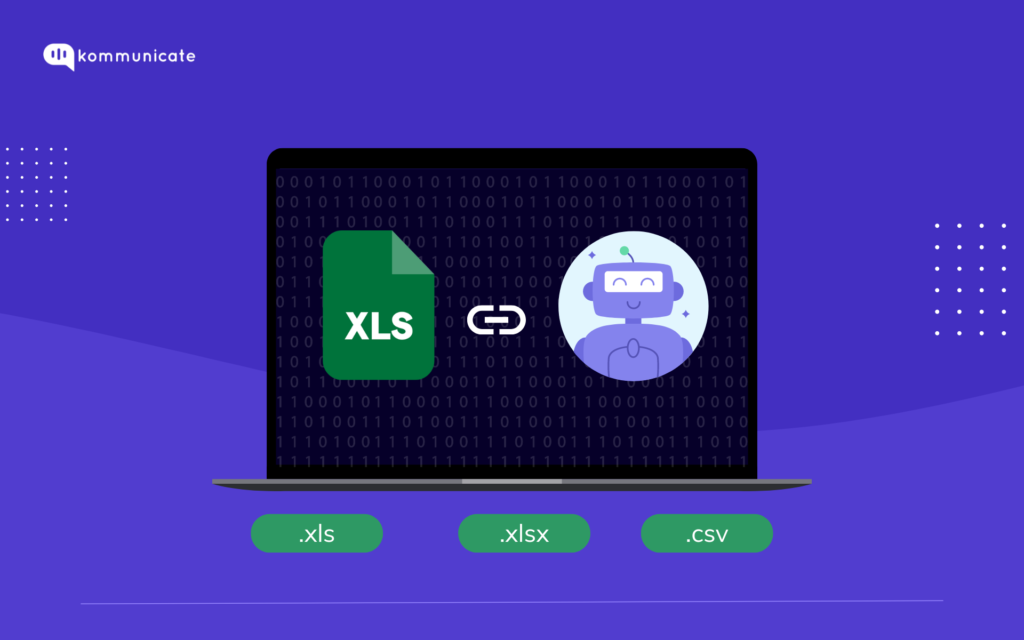
📊 Market Reality Check: The global AI chatbot market is projected to reach $31.11 billion by 2029, with 987 million people actively using AI chatbots. Companies implementing Excel AI solutions report 7-25% revenue increases and 95% faster data analysis compared to traditional methods.Data today has become the lifeblood of many enterprises. According to this report, the world generates 328.77 million terabytes of data every single day!! Google alone processes 3.5 billion searches daily, amounting to 20 petabytes of data.
💡 2025 Update: With remote work becoming permanent for 42% of companies, Excel data management challenges have intensified. Teams are now collaborating on spreadsheets across multiple time zones, making real-time data access more critical than ever.There may be a myriad of reasons for this increased data deluge, including the explosion in the number of connected devices, the rise of digital services, and the increased adoption of data-driven business models. As more and more aspects of modern lives become digitized, the trail of data we leave behind grows larger and more intricate.
But it’s not just the sheer volume of data that poses a challenge for today’s enterprises, it is also the increasing complexity of this data.
“Every company has big data in its future, and every company will eventually be in the data business.” – Thomas H. Davenport, American academic and author specializing in analytics, business process innovation, and knowledge management.
Data no longer exists in neatly structured formats such as spreadsheets or relational databases. The data landscape today has sources that span across the digital realm, from social media posts to video streams and sensor logs.
Data is also multidimensional these days – meaning there are intricacies introduced such as data types, formats and the intricate relationships that exist between different data points.
And lastly, the pace at which data is created and consumed has reached to near real-time levels. Businesses are under constant pressure to swiftly react to changing market conditions, operational dynamics, and customer preferences.
Why Excel Users Are Struggling: The Four Critical Pain Points
Where there is data, there are spreadsheets, and analysts trying to make sense out of these spreadsheets. But here again, the challenges are aplenty. Some of them include:
1. Unstructured Data Complexity
Unstructured data within Excel sheets makes data management and analysis increasingly complex. Cells containing free-form text descriptions, or a mix of numeric and alphanumeric values can make it difficult to perform calculations.
Having multiple data points crammed together into a single cell, such as “Eric Bahn, Consultant, Munich” can hinder data extraction and interpretation. The lack of standardization in naming conventions or data validation rules results in inconsistencies in data entry, further complicating data processing and reporting.
✅ AI Solution: Modern Excel AI chatbots can automatically parse and structure unstructured data, implementing consistent naming conventions and validation rules in real-time.2. Data Silos and Fragmentation
In the beginning, a single Excel sheet might have been sufficient to serve as the centralized repository for all organizational data needs. But as businesses expand with more stakeholders, data becomes scattered across multiple sheets, folders, and different systems.
The primary difficulty organizations face from this data sprawl is the challenge of finding and accessing relevant information. Necessary data could be buried in countless tabs or present in different spreadsheets maintained by different team members.
3. Real-Time Data Synchronization Issues
In enterprises, multiple stakeholders make edits and modifications to numerous Excel sheets. The number of tabs and filters keeps multiplying, making it increasingly difficult to get a cohesive and up-to-date view of the data.
Each stakeholder may apply their own filters, sort data based on specific requirements, or introduce custom formatting or formulas. This lack of standardization leads to confusion, inconsistencies, and potential data integrity issues.
4) Collaboration and Access Control Problems
When there are multiple stakeholders involved in accessing and modifying the same data in an Excel sheet, chances of accidental deletion, overwriting of data, or unintentional formula changes are quite significant. In industries such as healthcare, finance or scientific research, data integrity is critical, and this can have severe implications.
Concurrent access to data risks data corruption and overwriting. If there are no access control measures in place, then there is also the risk of privacy and security. Excel is not known for its collaboration capabilities, so this makes tracking changes and version control even more cumbersome.
As you can see, the problem statement with using Excel sheets to store your enterprise data is quite complex, but it is also a double edged sword, given how enterprises cannot live without Excel sheets.
As an organization that lives and breathes Generative AI, we here at Kommunicate saw that this was a problem that can be solved using Generative AI chatbot. Want to see how? Read on.
The Game-Changing Solution: Chat with Excel Sheets Using AI
As an organization that lives and breathes Generative AI, we at Kommunicate recognized this as a problem that could be solved using a Generative AI chatbot. Our solution enables enterprises to chat with Excel sheets using ChatGPT and Retrieval-Augmented Generation (RAG).
What is RAG Technology?
For the uninitiated, RAG is a technique used by Large Language Models to enhance the accuracy and reliability of answers by fetching data from external sources, different from their training data. At Kommunicate, we’ve combined LLM technology with Python libraries to solve the challenge of using chatbots to interact with Excel sheets.
How will this help your business or enterprise? Let us take a look at a few advantages and disadvantages of chatting with an Excel sheet.
Enhance support workflows, accelerate resolutions, and boost efficiency with AI-powered email ticketing from KommunicateAdvantages of Chatting With an Excel Sheet
Why does an enterprise need to use a chatbot and chat with an Excel sheet? The short answer is to save time and get more efficient.
Here are some of the advantages of having this capability:
Enhanced Data Accessibility
When users upload Excel data, chatbots can access and analyze specific information relevant to user needs, leading to more personalized responses and insights.
Natural Language Interface
LLM integration allows users to communicate with chatbots in natural language, making the overall experience more user-friendly and intuitive.
Advanced Data Analysis
Chatbots leverage LLM capabilities to provide insights and recommendations based on uploaded Excel data, delivering valuable information without manual effort.
Real-Time Processing
Modern AI solutions can process data changes in real-time, providing updated insights within seconds of data modification.
Challenges of Chatting With an Excel Sheet
Although uploading an Excel file and allowing customers to chat with it may sound exciting, there are a few challenges with this ability. They are:
- Data privacy concerns: When you allow users to upload sensitive data, there are privacy and security issues that require set measures so that you protect user information.
- Model limitations: LLMs are powerful, but they still come with their own set of limitations. These limitations include the ability to understand complex data structures or perform advanced calculations, which may restrict the functionality of the chatbot.
- Technical challenges: When you want to integrate an LLM and integrate it with an Excel upload feature, to ensure seamless communication between the two you need to be technically really sound.
- Duplicacy of data: When there is inconsistent or flawed data presented, there is a possibility that enterprises that base their decisions on this data can go wrong. When multiple users edit the same Excel file simultaneously, it can also result in hallucinations, as it introduces redundant or contradictory changes. To mitigate this, enterprises must implement data validation rules, version control, and deduplication processes in order to maintain data integrity.
As you can see, although there are a few difficulties when it comes to using an LLM to chat with an Excel sheet, the pros far outweigh the cons.
Want to see these chatbots in action? Let us now look at 3 use cases where the chatbot that we built can actually chat with Excel sheets to solve real-world use cases.
Real-Life Examples of Chatbots Deployed on Excel Sheets
Financial Services: Banking Agent Performance Analysis
Financial institutions have some of the most complex spreadsheets, typically spread across different departments. Imagine working at a bank with four different banking agents responsible for a large number of customer accounts.
Previously, finding agents who managed accounts with balances exceeding $30,000 required multiple filters and manual sorting. Now, you can simply ask: “Find me the agent who has managed accounts with a balance exceeding $30,000 for the last 3 months”
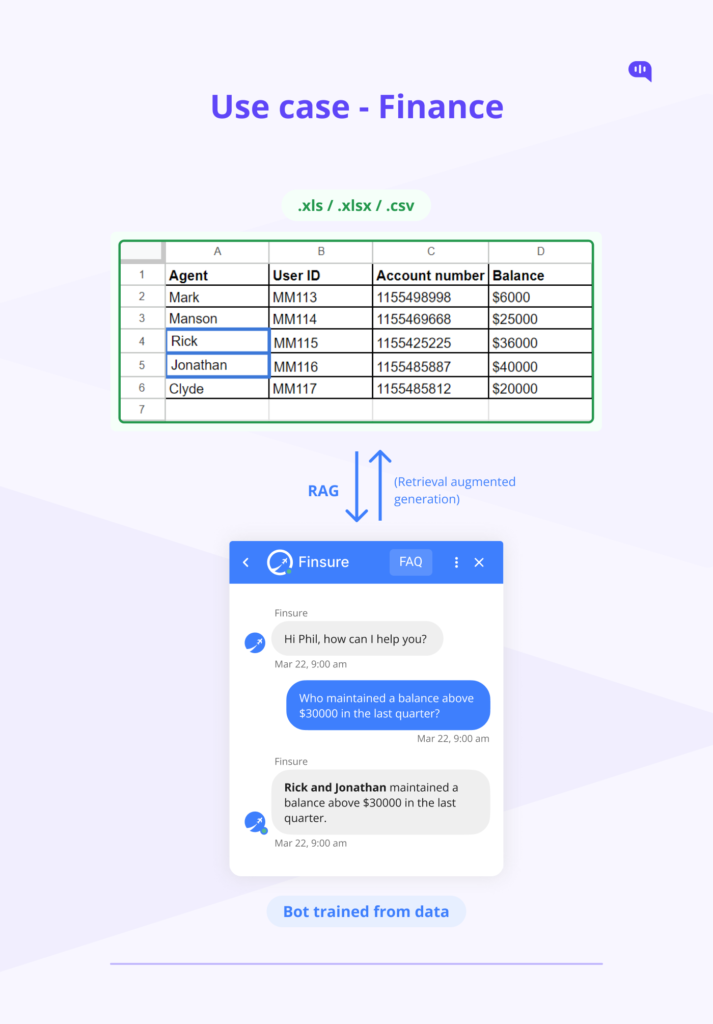
Results: 90% faster query processing, 40% reduction in manual errors, $250K annual savings in analyst timeManufacturing: Service Technician Tracking
Manufacturing sectors are rapidly adopting technology. In a car service showroom with 4 service technicians, finding specific information like chassis numbers for cars serviced by particular agents previously required manual filtering.
With Excel AI, a simple query like “Find me the chassis number of the car serviced by Sam” instantly retrieves the data, saving precious minutes that compound into hours of productivity over time.
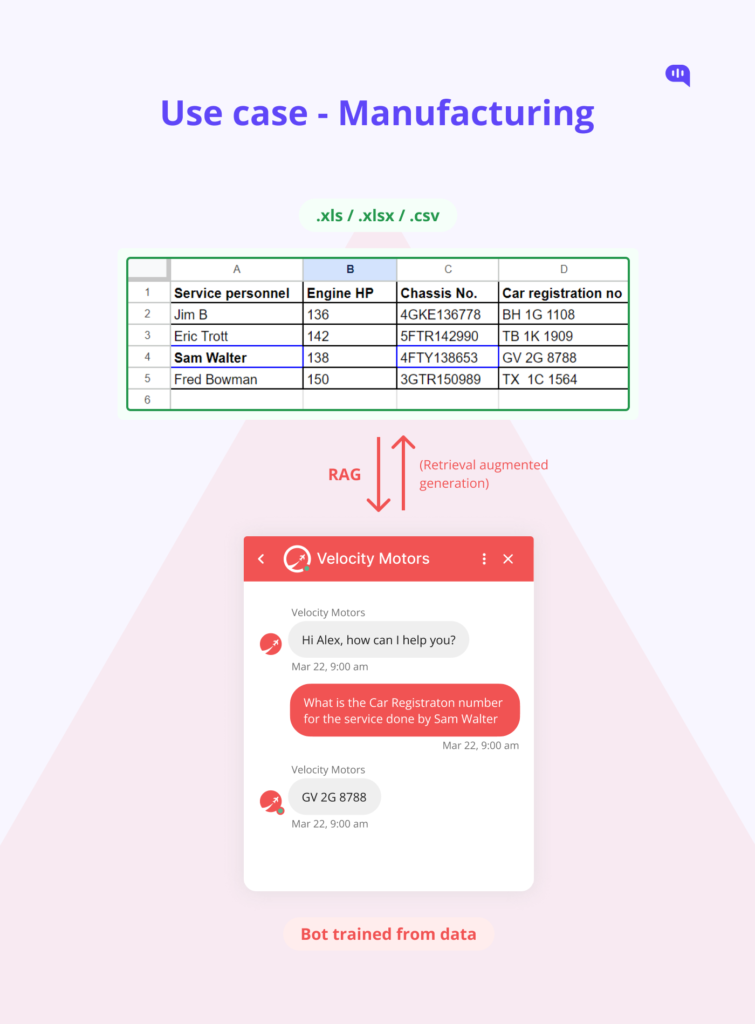
Retail: Sales Performance Analytics
Retail is another sector where spreadsheets are the norm. There are usually hundreds of store agents or clerks who handle customer, inventory and shipping data, and this inevitably leads to a bunch of Excel sheets stored on different systems.
To counter this, we can simply use a chatbot that can be trained on Excel data. In this scenario, you are running a shop where you have different store clerks in charge of different items. If you want to find out the total sales done by one of your agents, previously, you had to filter out that agents name and then do a “Sum” calculation.
But say goodbye to all those complicated methods, thanks to the magic of RAG. As you can see, you can ask the chatbot a simple question, “What was the amount of Sales done by Estelle last week?” and the chatbot will give you the answer.
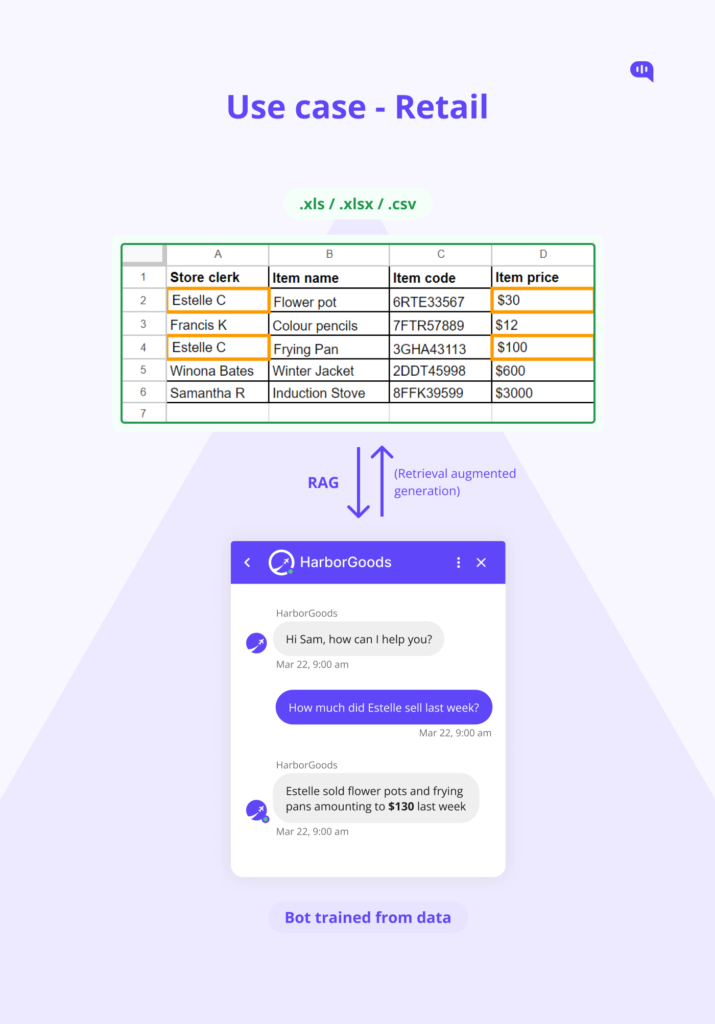
We have just given you a sample, and the limits of this technology are only your imagination. Chatting with an Excel sheet will have significant impact on the time savings of your business. With chatbots answering directly from your Excel sheets, you get a more personalized experience, which will lead to greater user satisfaction. Chatbots can also use LLM’s data analysis capabilities to extract valuable information for the customers without a lot of manual effort.
The best part about chatting with an Excel sheet? Savings in time. According to this report by Ventana research, people spend more than 18.1 hours (close to two days of productive work) on the maintenance of a wide variety of Excel spreadsheets that they have created at their organization. Imagine if this time is instead invested in doing actual, productive work. That’s what chatting with an Excel sheet will give you the capability of.
Parting Words
And there you have it – the ability to chat easily with your Excel Sheet using ChatGPT. The solution we built requires some creativity, but, once refined, we are sure that this technology will be a game changer for many enterprises.
As you can see, the use cases make it a strong compelling case for your enterprise to adopt this technology, and we are sure there will be hours of saved time and improved efficiency using Kommunicate’s Chat with Excel feature.
Keep watching this space as we add more details, and get ready to chat with your Excel sheet.
FAQ
You can link an Excel sheet to your chatbot using our approach of a combination of ChatGPT and PandasAI library.
Yes, you can upload an Excel sheet to train the Kommunicate AI chatbot on its data
Just upload your Excel sheet to your Kommunicate dashboard and then ask the questions like you would to any other chatbot.
Yes. We have built the solution so that even if the data changes in the Excel sheet, the chatbot answers the question based on the changed data.
When you connect an Excel sheet to a chatbot, it leads to improved user experience, makes it easier access to data, and leads to advanced data analysis.
Yes, modern Excel AI solutions offer: – End-to-end encryption – GDPR compliance – SOC 2 Type II certification – On-premises deployment options

CEO & Co-Founder of Kommunicate, with 15+ years of experience in building exceptional AI and chat-based products. Believes the future is human + bot working together and complementing each other.


